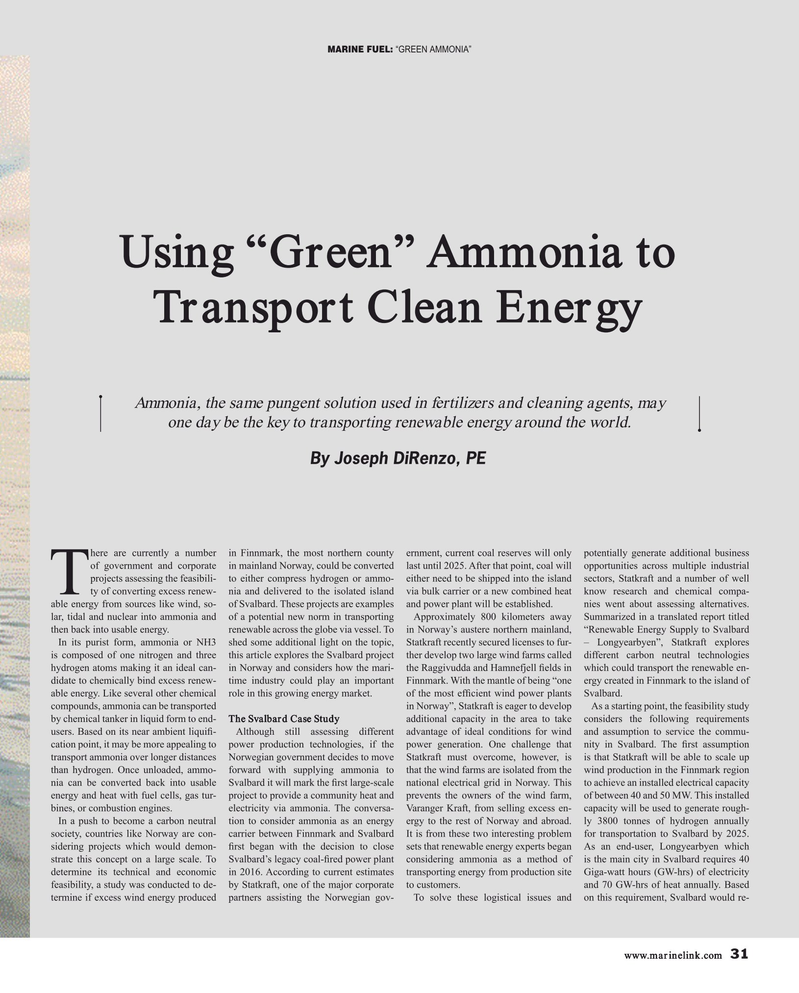
Page 31: of Maritime Reporter Magazine (September 2019)
Satellite Communications
Read this page in Pdf, Flash or Html5 edition of September 2019 Maritime Reporter Magazine
MARINE FUEL: “GREEN AMMONIA”
Using “Green” Ammonia to
Transport Clean Energy
Ammonia, the same pungent solution used in fertilizers and cleaning agents, may one day be the key to transporting renewable energy around the world.
By Joseph DiRenzo, PE here are currently a number in Finnmark, the most northern county ernment, current coal reserves will only potentially generate additional business of government and corporate in mainland Norway, could be converted last until 2025. After that point, coal will opportunities across multiple industrial projects assessing the feasibili- to either compress hydrogen or ammo- either need to be shipped into the island sectors, Statkraft and a number of well
Tty of converting excess renew- nia and delivered to the isolated island via bulk carrier or a new combined heat know research and chemical compa- able energy from sources like wind, so- of Svalbard. These projects are examples and power plant will be established. nies went about assessing alternatives. lar, tidal and nuclear into ammonia and of a potential new norm in transporting Approximately 800 kilometers away Summarized in a translated report titled then back into usable energy. renewable across the globe via vessel. To in Norway’s austere northern mainland, “Renewable Energy Supply to Svalbard
In its purist form, ammonia or NH3 shed some additional light on the topic, Statkraft recently secured licenses to fur- – Longyearbyen”, Statkraft explores is composed of one nitrogen and three this article explores the Svalbard project ther develop two large wind farms called different carbon neutral technologies hydrogen atoms making it an ideal can- in Norway and considers how the mari- the Raggivudda and Hamnefjell ? elds in which could transport the renewable en- didate to chemically bind excess renew- time industry could play an important Finnmark. With the mantle of being “one ergy created in Finnmark to the island of able energy. Like several other chemical role in this growing energy market. of the most ef? cient wind power plants Svalbard. compounds, ammonia can be transported in Norway”, Statkraft is eager to develop As a starting point, the feasibility study by chemical tanker in liquid form to end- The Svalbard Case Study additional capacity in the area to take considers the following requirements users. Based on its near ambient liqui? - Although still assessing different advantage of ideal conditions for wind and assumption to service the commu- cation point, it may be more appealing to power production technologies, if the power generation. One challenge that nity in Svalbard. The ? rst assumption transport ammonia over longer distances Norwegian government decides to move Statkraft must overcome, however, is is that Statkraft will be able to scale up than hydrogen. Once unloaded, ammo- forward with supplying ammonia to that the wind farms are isolated from the wind production in the Finnmark region nia can be converted back into usable Svalbard it will mark the ? rst large-scale national electrical grid in Norway. This to achieve an installed electrical capacity energy and heat with fuel cells, gas tur- project to provide a community heat and prevents the owners of the wind farm, of between 40 and 50 MW. This installed bines, or combustion engines. electricity via ammonia. The conversa- Varanger Kraft, from selling excess en- capacity will be used to generate rough-
In a push to become a carbon neutral tion to consider ammonia as an energy ergy to the rest of Norway and abroad. ly 3800 tonnes of hydrogen annually society, countries like Norway are con- carrier between Finnmark and Svalbard It is from these two interesting problem for transportation to Svalbard by 2025. sidering projects which would demon- ? rst began with the decision to close sets that renewable energy experts began As an end-user, Longyearbyen which strate this concept on a large scale. To Svalbard’s legacy coal-? red power plant considering ammonia as a method of is the main city in Svalbard requires 40 determine its technical and economic in 2016. According to current estimates transporting energy from production site Giga-watt hours (GW-hrs) of electricity feasibility, a study was conducted to de- by Statkraft, one of the major corporate to customers. and 70 GW-hrs of heat annually. Based termine if excess wind energy produced partners assisting the Norwegian gov- To solve these logistical issues and on this requirement, Svalbard would re- www.marinelink.com 31
MR #9 (26-33).indd 31 MR #9 (26-33).indd 31 9/11/2019 9:46:28 AM9/11/2019 9:46:28 AM

 30
30

 32
32
